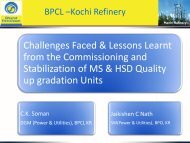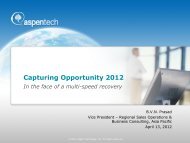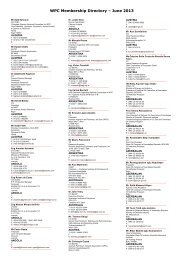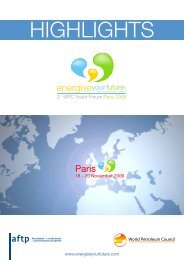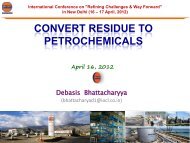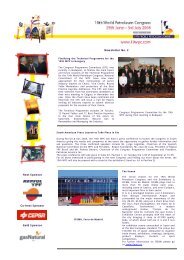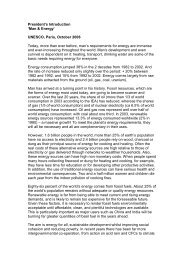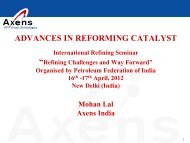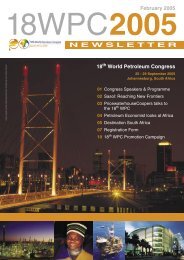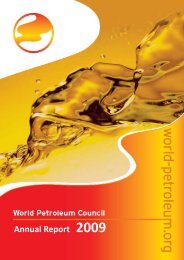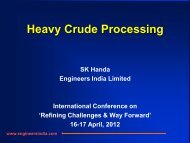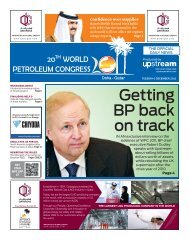Enhanced oil recovery: challenges and opportunities - World ...
Enhanced oil recovery: challenges and opportunities - World ...
Enhanced oil recovery: challenges and opportunities - World ...
Create successful ePaper yourself
Turn your PDF publications into a flip-book with our unique Google optimized e-Paper software.
ENVIRONMENT AND SUSTAINABILITY<br />
<strong>Enhanced</strong> <strong>oil</strong> <strong>recovery</strong>:<br />
<strong>challenges</strong> & <strong>opportunities</strong><br />
BY SUNIL KOKAL AND ABDULAZIZ AL-KAABI<br />
EXPEC ADVANCED RESEARCH CENTRE, SAUDI ARAMCO<br />
Recovery is at the heart of <strong>oil</strong> production from<br />
underground reservoirs. If the average worldwide<br />
<strong>recovery</strong> factor from hydrocarbon reservoirs can be<br />
increased beyond current limits, it will alleviate a number of<br />
issues related to global energy supply. Currently the daily<br />
<strong>oil</strong> production comes from mature or maturing <strong>oil</strong> fields <strong>and</strong><br />
reserves replacement is not keeping pace with the growing<br />
energy dem<strong>and</strong>. The world average <strong>recovery</strong> factor from<br />
hydrocarbon reservoirs is stuck in the mid-30 per cent<br />
range. This challenge becomes an opportunity for advanced<br />
secondary <strong>and</strong> enhanced <strong>oil</strong> <strong>recovery</strong> (EOR) technologies that<br />
may mitigate the dem<strong>and</strong>-supply balance.<br />
This paper presents a big-picture overview of EOR<br />
technologies with the focus on <strong>challenges</strong> <strong>and</strong> <strong>opportunities</strong>.<br />
The implementation of EOR is intimately tied to the price of <strong>oil</strong><br />
<strong>and</strong> overall economics. EOR is capital <strong>and</strong> resource intensive,<br />
<strong>and</strong> expensive, primarily due to high injectant costs. The<br />
timing of EOR is also important: a case is made that advanced<br />
secondary <strong>recovery</strong> (improved <strong>oil</strong> <strong>recovery</strong> or IOR) technologies<br />
are a better first option before full-field deployment of EOR.<br />
Realisation of EOR potential can only be achieved through<br />
long-term commitments, both in capital <strong>and</strong> human resources,<br />
a vision to strive towards ultimate <strong>oil</strong> <strong>recovery</strong> instead of<br />
immediate <strong>oil</strong> <strong>recovery</strong>, research <strong>and</strong> development, <strong>and</strong> a<br />
willingness to take risks. While EOR technologies have grown<br />
over the years, significant <strong>challenges</strong> remain. Some of the<br />
enablers for EOR are also discussed in this paper.<br />
EOR/IOR definitions<br />
At this stage, it is important to define EOR. There is a lot<br />
of confusion around the usage of the terms EOR <strong>and</strong> IOR.<br />
Figure 1 shows these in terms of <strong>oil</strong> <strong>recovery</strong>, as defined by<br />
the Society of Petroleum Engineers (SPE) 1,2 . Primary <strong>and</strong><br />
Figure 1: EOR/IOR definition<br />
Production (KB/d)<br />
2000<br />
1500<br />
1000<br />
500<br />
0<br />
Figure 2: <strong>World</strong>wide EOR production rates<br />
>100<br />
Number of Projects <strong>World</strong>wide<br />
TECHNOLOGY AND INNOVATION<br />
the US (mostly Alaska), Canada <strong>and</strong> Libya. Hydrocarbon gas<br />
injection is mostly implemented where the gas supply cannot<br />
be monetised. Production from chemical EOR is practically all<br />
from China with the total worldwide production of another third<br />
of a million barrels per day. Other more esoteric methods, like<br />
microbial have only been field-tested without any significant<br />
quantities being produced on a commercial scale.<br />
These numbers were taken from the SPE literature, Oil <strong>and</strong><br />
Gas Journal 3 <strong>and</strong> other sources, <strong>and</strong> probably are a little<br />
conservative because some of the projects are not reported,<br />
especially the new ones. A better estimate of the total EOR<br />
production will be about 10-20 per cent higher than the<br />
3 million per day figure quoted above.<br />
EOR current status<br />
The global average or aggregate <strong>recovery</strong> factor from <strong>oil</strong><br />
reservoirs is about a third. This is considered low <strong>and</strong> leaves<br />
a substantial amount of <strong>oil</strong> underground. A global effort has<br />
been under way for some time to increase this number <strong>and</strong><br />
one reason for its failure is the relationship between <strong>oil</strong> price<br />
<strong>and</strong> resource availability. Figure 3, from the International Energy<br />
Agency, shows the connection between production cost <strong>and</strong> <strong>oil</strong><br />
resources <strong>and</strong> the cost of converting them to reserves.<br />
The cheapest injectant for producing <strong>oil</strong> is water. As long as<br />
companies can produce <strong>oil</strong> by injecting water, they will continue<br />
to do so. Another ~2 trillion barrels of <strong>oil</strong> can be produced with<br />
the price of <strong>oil</strong> below US$40 (2008 $) per barrel. Many of the<br />
EOR technologies kick in when the price of <strong>oil</strong> is between<br />
US$20-80 per barrel. In the early 1980s there was tremendous<br />
interest generated in EOR due to <strong>oil</strong> price escalation. The<br />
number of EOR projects <strong>and</strong> R&D investment peaked in 1986.<br />
The interest fizzled out in the 1990s <strong>and</strong> early 2000s with a<br />
collapse in the price of <strong>oil</strong>. A renewed <strong>and</strong> growing interest<br />
has taken hold during the past 5 years as the price of <strong>oil</strong> has<br />
increased again. Figure 4 shows this relationship between EOR<br />
projects <strong>and</strong> <strong>oil</strong> price. There is a lag between the price of <strong>oil</strong> <strong>and</strong><br />
EOR projects. In the last price escalation, interest was mostly in<br />
the US but this time the interest in EOR projects is global.<br />
Besides the link of EOR to <strong>oil</strong> price, the projects are generally<br />
complex, technology-heavy <strong>and</strong> require considerable capital<br />
investment <strong>and</strong> financial risks. The risks are aggravated with<br />
the fluctuations in the price of <strong>oil</strong>. The unit costs of EOR <strong>oil</strong> are<br />
substantially higher than those of secondary or conventional<br />
<strong>oil</strong>. Another challenge for EOR projects is the long lead time<br />
required for such projects. Typically, it may take several<br />
decades from the start of the concept – generating laboratory<br />
data <strong>and</strong> conducting simulation studies – to the first pilot <strong>and</strong><br />
finally, full commercialisation. Two examples are given here, one<br />
each for thermal (Figure 5) <strong>and</strong> miscible gas injection (Figure 6)<br />
*IEA<br />
Figure 3: Oil price <strong>and</strong> resources availability<br />
projects. While there has been some discussion in the literature<br />
of applying or deploying EOR at an early stage of a reservoir’s<br />
life, this is generally difficult, <strong>and</strong> not necessarily the best option,<br />
due to the risks involved <strong>and</strong> lack of data availability, that can<br />
easily be obtained during the secondary stage of <strong>recovery</strong>.<br />
The two most popular EOR methods as discussed below are<br />
thermal (steam) <strong>and</strong> miscible gas injection, which are mature<br />
technologies. In chemical EOR, polymer injection is reaching<br />
commercial status (Figure 7). Acid gas injection, in-situ<br />
combustion (including the newer high-pressure air injection,<br />
(HPAI)) <strong>and</strong> combination chemical flooding are still in the<br />
technology development stage. Microbial, hybrid <strong>and</strong> other<br />
novel technologies are in the R&D stage. This compounds<br />
<strong>and</strong> restricts the application of EOR for a given field. If thermal<br />
<strong>and</strong> miscible gas injection methods are applicable to a given<br />
reservoir, then the decision to move forward is a little easier. If<br />
not, the decision is harder, <strong>and</strong> depends on the availability of<br />
injectant, economics <strong>and</strong> other factors previously discussed.<br />
EOR technology matrix<br />
EOR methods are classified by the main mechanism of <strong>oil</strong><br />
displacement 4-9 . There are really just three basic mechanisms for<br />
recovering <strong>oil</strong> from rock other than by water alone. The methods<br />
are grouped according to those which rely on (a) A reduction of<br />
<strong>oil</strong> viscosity, (b) The extraction of the <strong>oil</strong> with a solvent, <strong>and</strong> (c)<br />
The alteration of capillary <strong>and</strong> viscous forces between the <strong>oil</strong>,<br />
injected fluid, <strong>and</strong> the rock surface. EOR methods are therefore<br />
classified into the following three categories:<br />
• Thermal methods (injection of heat);<br />
• Miscible gas injection methods (injection of a solvent);<br />
• Chemical methods (injection of chemicals/surfactants).<br />
Global Energy Solutions 65
ENVIRONMENT AND SUSTAINABILITY<br />
Thermal EOR<br />
Thermal EOR methods are generally applicable to heavy,<br />
viscous crudes, <strong>and</strong> involve the introduction of thermal energy<br />
or heat into the reservoir to raise the temperature of the <strong>oil</strong><br />
<strong>and</strong> reduce its viscosity. Steam (or hot water) injection <strong>and</strong><br />
in-situ combustion are the popular thermal <strong>recovery</strong> methods.<br />
Three common methods involving steam injection are cyclic<br />
steam stimulation (huff <strong>and</strong> puff), steam flooding <strong>and</strong> steam<br />
assisted gravity drainage (SAGD). In-situ combustion involves<br />
the injection of air, where the <strong>oil</strong> is ignited, generates heat<br />
internally <strong>and</strong> also produces combustion gases, which<br />
enhance <strong>recovery</strong>.<br />
Steam injection has been most popular in heavy <strong>oil</strong><br />
s<strong>and</strong> reservoirs with ongoing projects in Alberta (Canada),<br />
Venezuela, California, Indonesia, the former Soviet Union, <strong>and</strong><br />
Oman 3 . Lesser (small commercial or field trials) have been<br />
reported in Brazil, China, Trinidad <strong>and</strong> Tobago, <strong>and</strong> other<br />
countries. SAGD has been mostly popular in the <strong>oil</strong> s<strong>and</strong>s<br />
<strong>and</strong> extra-heavy crudes of Alberta, <strong>and</strong> tested in Venezuela<br />
with limited success. Several hybrid versions of SAGD have<br />
been reported but remain at field-trial levels only 6 .<br />
In-situ combustion projects, not as popular as steam<br />
flooding, have been reported in Canada, India, Romania, <strong>and</strong><br />
the US. It has been applied mostly to heavy <strong>oil</strong> s<strong>and</strong>stone<br />
reservoirs. A new version, HPAI, for light crudes has been<br />
gaining in popularity over the past 10 years <strong>and</strong> shows<br />
potential, especially in light <strong>oil</strong>s <strong>and</strong> low permeability carbonate<br />
reservoirs. Several projects have been concentrated in the<br />
north-western US <strong>and</strong> Mexico is also considering HPAI for<br />
one of its fields.<br />
The future of thermal methods is perhaps the brightest for<br />
the more difficult heavy <strong>oil</strong> <strong>and</strong> tar s<strong>and</strong>s resources. Currently,<br />
Figure 4: EOR projects <strong>and</strong> <strong>oil</strong> price correlation<br />
Data from Oil & Gas Journal, EIA <strong>and</strong> other sources<br />
SAGD is primarily being applied in Alberta <strong>and</strong> several hybrid<br />
technologies (e.g. injection of solvent with steam) are being<br />
tested. This technology is ripe for being applied in other parts<br />
of the world. Air injection, if tamed <strong>and</strong> understood, may also<br />
have applications in light <strong>oil</strong> reservoirs as the injectant supply<br />
is plentiful. Steam flooding too has been tested successfully in<br />
light <strong>oil</strong> reservoirs that satisfy certain criteria (depth < 3,000 ft,<br />
<strong>oil</strong> saturation-porosity product > 0.1).<br />
Miscible gas EOR<br />
Gas injection, especially CO 2 , is another popular EOR<br />
method, <strong>and</strong> is applicable to light <strong>oil</strong> reservoirs, in both<br />
carbonates <strong>and</strong> s<strong>and</strong>stones. Its popularity is expected to<br />
increase for two reasons: increased <strong>oil</strong> <strong>recovery</strong> through<br />
miscibility <strong>and</strong> disposal of a greenhouse gas. There are<br />
over 100 commercial CO 2 -EOR projects, the bulk of them<br />
concentrated in the west Texas carbonates of the Permian<br />
Basin in the US. Their success has partially been due to the<br />
availability of low-cost natural CO 2 from nearby fields <strong>and</strong><br />
reservoirs. Another important CO 2 -EOR project is Weyburn-<br />
Midale in Saskatchewan (Canada) where CO 2 is sourced from<br />
a gasification plant in North Dakota <strong>and</strong> piped across the<br />
border. Many other CO 2 -EOR projects are on the drawing<br />
board as a result of environmental reasons (sequestration).<br />
Hydrocarbon gas is also an excellent solvent for light <strong>oil</strong><br />
reservoirs, if available. In places where it cannot be monetised<br />
(no local market), it can be injected into an <strong>oil</strong> reservoir for<br />
EOR. This has been the case in Alaska, Venezuela, Libya<br />
<strong>and</strong> Canada. Other gases, such as nitrogen (Cantarell field,<br />
Mexico) <strong>and</strong> acid or sour gases (Tengiz field, Kazakhstan,<br />
Harweel field, Oman <strong>and</strong> Zama field, Canada), have, or will be<br />
injected, although to a lesser extent than CO 2 <strong>and</strong> hydrocarbon<br />
gases. The current <strong>challenges</strong> in gas injection as an EOR method<br />
are gravity segregation, <strong>and</strong> most importantly, availability of a<br />
low-cost gas source.<br />
The future of gas injection lies primarily with CO 2 . There is<br />
a concerted effort around the world to reduce carbon capture<br />
costs. Once this becomes feasible, injection of CO 2 may<br />
become widespread in light <strong>oil</strong> reservoirs. Hydrocarbon gas<br />
injection has limited potential except where there is no market<br />
for it.<br />
Chemical EOR<br />
In chemical EOR or chemical flooding, the primary goal is to<br />
recover more <strong>oil</strong> by either one or a combination of the following<br />
processes: (1) Mobility control by adding polymers to reduce<br />
the mobility of the injected water, <strong>and</strong> (2) Interfacial tension (IFT)<br />
reduction by using surfactants, <strong>and</strong>/or alkalis. Considerable<br />
research <strong>and</strong> pilot testing was done in the 1980s <strong>and</strong> a string<br />
66 <strong>World</strong> Petroleum Council: Official Publication 2010
TECHNOLOGY AND INNOVATION<br />
Figure 5: Timing of EOR: Cold Lake – Canada<br />
of projects were implemented during that time, mostly in the<br />
US. Consequently, none of those projects were successful, at<br />
least economically. The only place where chemical EOR has<br />
been successful, especially polymer, is in China over the last<br />
decade. Based on the success in China <strong>and</strong> the recent increase<br />
in <strong>oil</strong> price, a renewed vigour has come into chemical EOR<br />
<strong>and</strong> several field trials <strong>and</strong> pilots are ongoing, <strong>and</strong>/or on the<br />
drawing board. The famous one is the Marmul field in Oman.<br />
Other projects are in Canada, the US, India, Argentina, Brazil,<br />
Austria <strong>and</strong> Argentina. Surfactant injection has not produced<br />
any successes <strong>and</strong> remains challenging, especially in a high<br />
salinity, high temperature environment. Alkalis, although<br />
cheap, bring along a string of operational headaches (scaling,<br />
emulsions, plugging, etc.). Nearly all of the polymer floods have<br />
been implemented in s<strong>and</strong>stones, <strong>and</strong> carbonates remain a<br />
major challenge.<br />
Chemical EOR faces significant <strong>challenges</strong>, especially in<br />
light <strong>oil</strong> reservoirs. One of the reasons is the availability, or<br />
lack of, compatible chemicals in high temperature <strong>and</strong> high<br />
salinity environments. Figure 8 shows the current limitation on<br />
a salinity-temperature plot. R&D will play a critical role in the<br />
future of chemical EOR.<br />
improve <strong>oil</strong> <strong>recovery</strong> <strong>and</strong> should be considered before fullscale<br />
deployment of EOR.<br />
Another option to consider before EOR is ‘smart water<br />
flooding’. Here, the idea is to inject water with an optimised<br />
composition (in terms of salinity <strong>and</strong> ionic composition) into<br />
the reservoir instead of any available water that may currently<br />
be injected or planned to be injected. Recent research has<br />
shown 11,12 that salinity <strong>and</strong>/or ionic composition can play a<br />
significant role in <strong>oil</strong> <strong>recovery</strong> during water flooding <strong>and</strong> may<br />
yield up to 10 per cent or higher additional <strong>oil</strong> recoveries when<br />
compared to unoptimised water injection. This option has<br />
several advantages compared to EOR:<br />
• It can achieve higher ultimate <strong>oil</strong> <strong>recovery</strong> with minimal<br />
investment in current operations (this assumes that a waterflooding<br />
infrastructure is already in place). The advantage<br />
lies in avoiding extensive capital investment associated with<br />
conventional EOR methods, such as expenditure on new<br />
infrastructure <strong>and</strong> plants needed for injectants, new injection<br />
facilities, production <strong>and</strong> monitoring wells, changes in tubing<br />
<strong>and</strong> casing, for example.<br />
• It can be applied during the early life cycle of the reservoir,<br />
unlike EOR.<br />
• The payback is faster, even with small incremental <strong>oil</strong> <strong>recovery</strong>.<br />
Figure 9 shows the results from a BP study 11 of incremental<br />
<strong>oil</strong> recoveries (over <strong>and</strong> above water-flooding recoveries) in<br />
several s<strong>and</strong>stone reservoirs.<br />
Smart water flooding is relatively new <strong>and</strong> in the technology<br />
development stage, however, the idea of customised water<br />
for improving <strong>oil</strong> <strong>recovery</strong> is very attractive. There have been<br />
a few field trials <strong>and</strong> pilots, mostly in s<strong>and</strong>stones, <strong>and</strong> fewer<br />
in carbonates. The initial results are promising <strong>and</strong> a number<br />
of questions remain, although R&D has been accelerating in<br />
Figure 6: Timing of EOR: Weyburn project in Canada<br />
Advanced IOR <strong>and</strong> best practices<br />
A good ‘first’ option for any reservoir is to maximise secondary<br />
stage <strong>recovery</strong>. Advances in technology <strong>and</strong> the utilisation<br />
of best-in-class reservoir management practices will enable<br />
the maximisation of water flooding <strong>oil</strong> <strong>recovery</strong> before<br />
deploying EOR. Saudi Aramco is perhaps the world leader in<br />
optimising the <strong>recovery</strong> from its reservoirs through prudent<br />
reservoir management practices. Some of these include 10<br />
the deployment of maximum reservoir contact wells (MRC),<br />
intelligent autonomous fields, gigacell simulation, deep<br />
diagnostics (ability to see inside the reservoir with clarity), <strong>and</strong><br />
advanced monitoring <strong>and</strong> surveillance technologies. These<br />
are just a fraction of available technologies that may help<br />
Global Energy Solutions 67
this area. Saudi Aramco, through its upstream arm (EXPEC<br />
Advanced Research Centre), has initiated a strategic research<br />
programme in this area to explore the potential of increasing<br />
<strong>oil</strong> <strong>recovery</strong> by tuning the injected water properties.<br />
Another aspect of water flooding that can be improved is<br />
the monitoring <strong>and</strong> surveillance (M&S) of projects. In many<br />
cases, adequate monitoring is not done because of the cost<br />
involved. This may, however, be detrimental to the overall<br />
<strong>recovery</strong> during water flooding. While an optimum M&S<br />
plan cannot be predetermined for a given reservoir, some<br />
of its components include: the time-tested open/cased hole<br />
logging, coring, flood-front monitoring, single <strong>and</strong> interwell<br />
tracer tests, <strong>and</strong> emerging technologies, such as: borehole<br />
gravimetry, crosswell <strong>and</strong> borehole to surface electromagnetic<br />
(EM), <strong>and</strong> geophysical methods (crosswell seismic, 4D seismic<br />
<strong>and</strong> 4D vertical seismic profiler (VSP)). A good M&S plan is<br />
essential in optimising <strong>oil</strong> <strong>recovery</strong> at the secondary <strong>recovery</strong><br />
stage, <strong>and</strong> even more important during the EOR phase.<br />
EOR enablers<br />
Significant <strong>challenges</strong> still remain for the widespread<br />
deployment of EOR. Ultimately, however, companies will have<br />
to resort to EOR as the ‘easy <strong>oil</strong>’ gets depleted. This section<br />
discusses some of the EOR ‘enablers’ 5 .<br />
Focus on ultimate <strong>oil</strong> <strong>recovery</strong><br />
There is a concerted move around the world as companies<br />
(especially the national <strong>oil</strong> companies, <strong>and</strong> increasingly the<br />
international <strong>oil</strong> companies) realise that they need to focus on<br />
‘ultimate’ <strong>oil</strong> <strong>recovery</strong> <strong>and</strong> not on ‘immediate’ <strong>oil</strong> <strong>recovery</strong> that<br />
is driven by short-term profits. This commitment to a long-term<br />
view will ensure the optimum exploitation of <strong>oil</strong> resources by<br />
keeping depletion rates low, improving secondary <strong>oil</strong> <strong>recovery</strong><br />
through sustainable development <strong>and</strong> focusing on long-term<br />
profits. Appropriate EOR methods can then be deployed to<br />
maximise ultimate <strong>oil</strong> <strong>recovery</strong>.<br />
Moving towards difficult resources<br />
As the easy <strong>and</strong> conventional light <strong>oil</strong> gets depleted, a move<br />
towards more difficult hydrocarbon resources is already<br />
well under way. These resources include heavy <strong>and</strong> extraheavy<br />
crudes, <strong>oil</strong> s<strong>and</strong>s, bitumen <strong>and</strong> shale <strong>oil</strong>. Typically, the<br />
conventional <strong>oil</strong> <strong>recovery</strong> for these resources is generally low.<br />
An EOR method has to be implemented relatively early in these<br />
reservoirs. This has been, <strong>and</strong> will be, a primary driver for EOR,<br />
especially thermal, in the more difficult resources worldwide.<br />
Life-cycle planning<br />
A more holistic approach in the life-cycle planning of a<br />
reservoir is happening across the industry. The motivation<br />
towards maximising <strong>recovery</strong>, rather than thinking about shortterm<br />
profits, helps in better resource exploitation. Life-cycle<br />
planning includes thinking about EOR early enough to conduct<br />
relevant R&D studies, feasibility testing <strong>and</strong> conducting pilots<br />
to enable key decisions to be made at the right time.<br />
R&D<br />
Investment in R&D is essential to generate the right options<br />
for field development. Often, in a drive to produce <strong>oil</strong> as fast<br />
as possible, incorrect strategy is adopted to develop an<br />
Figure 7: IOR/EOR maturity <strong>and</strong> deployment<br />
Figure 8: Chemical EOR <strong>challenges</strong><br />
68 <strong>World</strong> Petroleum Council: Official Publication 2010
TECHNOLOGY AND INNOVATION<br />
<strong>oil</strong> reservoir. This can lower the overall<br />
<strong>recovery</strong> from the reservoir considerably.<br />
Proper R&D investment, especially early on,<br />
not only assures a good overall strategy for<br />
secondary <strong>recovery</strong>, but for EOR as well. A<br />
good example is the Marmul field in Oman<br />
where R&D studies <strong>and</strong> pilot testing with<br />
chemicals were done in the 1980s. This<br />
data <strong>and</strong> results helped PDO (Oman) <strong>and</strong><br />
Shell to implement chemical EOR with<br />
little difficulty at a later date. Another good<br />
example is China, where R&D investment<br />
in chemical EOR has paid off h<strong>and</strong>somely<br />
with successful implementation of full-field<br />
EOR projects (two examples: Daqing <strong>and</strong><br />
Shengli fields).<br />
Figure 9: Summary of low salinity <strong>recovery</strong> benefits for various fields<br />
Capability development<br />
EOR projects are inherently complex compared to conventional<br />
<strong>recovery</strong> methods. These projects are also manpowerintensive,<br />
requiring highly-skilled professionals to run them.<br />
For companies that nurture, develop <strong>and</strong> possess these<br />
competencies, implementation of EOR will be easier. In addition,<br />
EOR professionals also ensure better IOR implementation<br />
strategies.<br />
Stepwise implementation<br />
EOR projects are also facilitated by stepwise implementation<br />
<strong>and</strong> integration of R&D, technology, people, <strong>and</strong> commitment.<br />
A stepwise implementation involves moving from laboratory<br />
scale tests, single well tests, pilot tests <strong>and</strong> on to full-field<br />
implementation. This will significantly reduce risks associated<br />
with typical EOR projects, <strong>and</strong> eventually improve overall<br />
economics.<br />
Energy security<br />
EOR implementation may be aided by a company’s or country’s<br />
need for energy security concerns. The US is a prime example<br />
of this need <strong>and</strong> has taken a true leadership role in EOR<br />
implementation in its fields, in spite of being a free economy.<br />
Another example is PDO where the dwindling <strong>oil</strong> production<br />
rates have forced it to implement EOR projects aggressively.<br />
Environmental concerns<br />
In recent years, a strong boost to EOR has come from<br />
environmental concerns. This is especially true for CO 2 -EOR.<br />
CO 2 , a greenhouse gas, has been closely linked to global<br />
climate change. There are incentives to sequester this CO 2 .<br />
It is also a very good solvent for light crudes <strong>and</strong> is generally<br />
miscible with the <strong>oil</strong> at moderate reservoir pressures. The<br />
number of projects injecting CO 2 for EOR has been steadily<br />
rising <strong>and</strong> is anticipated to increase further in the foreseeable<br />
future. In many ways, this is a win-win situation, sequestering<br />
CO 2 at the same time as producing incremental <strong>oil</strong>. ❏<br />
1. Stosur, G.J.: “EOR: Past, Present <strong>and</strong> What the Next 25 Years May Bring,” SPE<br />
paper 84864, presented at the SPE IOR Conference in Asia Pacific, Kuala Lumpur,<br />
Malaysia, October 20-21, 2003.<br />
2. Stosur, G.J., Hite, J.R. <strong>and</strong> Carnahan, N.F.: “The Alphabet Soup of IOR, EOR <strong>and</strong><br />
AOR: Effective Communication Requires a Definition of Terms,” SPE paper 84908,<br />
presented at the SPE International IOR Conference in Asia Pacific, Kuala Lumpur,<br />
Malaysia, October 20-21, 2003.<br />
3. Moritis, G.: “CO 2 , Miscible, Steam Dominate EOR Processes,” Oil <strong>and</strong> Gas J.,<br />
April 2010.<br />
4. Thomas, S., “EOR – An Overview”, Oil <strong>and</strong> Gas Science <strong>and</strong> Technology, Rev.<br />
IFP, Vol 63, #1, (2008).<br />
5. Schulte, W.M.: “Challenges <strong>and</strong> Strategy for Increased Oil Recovery,” IPTC paper<br />
10146, presented at the IPTC, Doha, Qatar, November 21-23, 2005.<br />
6. Manirique, E., Thomas, C., Ravikiran, R., et al.: “EOR: Current Status <strong>and</strong><br />
Opportunities,” SPE paper 130113, presented at the IOR Symposium, Tulsa, OK,<br />
April 26-28, 2010.<br />
7. Wilkinson, J.R., Teletzke, G.F. <strong>and</strong> King, K.C.: “Opportunities <strong>and</strong> Challenges for<br />
EOR in the Middle East,” SPE paper 101679, presented at the Abu Dhabi IPTC, Abu<br />
Dhabi, U.A.E., November 5-8, 2006.<br />
8. Manrique, E.J., Muci, V.E. <strong>and</strong> Gurfinkel, M.E.: “EOR Field Experiences in<br />
Carbonate Reservoirs in the US,” SPEREE, December 2007.<br />
9. Awan, A.R., Teigl<strong>and</strong>, R. <strong>and</strong> Kleppe, J.: “EOR Survey in the North Sea,” SPE<br />
paper 99546, presented at the SPE IOR Symposium, Tulsa, OK, April 22-26, 2006.<br />
10. Saggaf, M.: “A Vision for Future Upstream Technologies,” JPT, March 2008.<br />
11. Lager, A., Webb, K.J. <strong>and</strong> Black, J.J.: “Impact of Brine Chemistry on Oil<br />
Recovery,” Paper A24, presented at the EAGE IOR Symposium, Cairo, Egypt, April<br />
22-24, 2007.<br />
12. Str<strong>and</strong>, S., Austad, T., Puntervold, T., Høgnesen, E.J., Olsen. M. <strong>and</strong> Barstad,<br />
S.M.: “Smart Water for Oil Recovery from Fractured Limestone: A Preliminary Study,”<br />
Journal of Petroleum Science <strong>and</strong> Engineering, 2009.<br />
Global Energy Solutions 69



